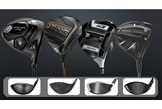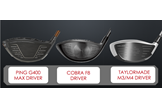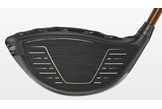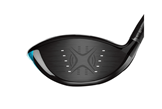Battle of the 2018 driver faces: A manufacturer Q&A
Published: Last updated:
Battle of the 2018 driver faces: We asked leading manufacturers Ping, Cobra, TaylorMade and Callaway all about the faces on their latest drivers.
The Ping G400 Max, Cobra F8, TaylorMade M3/M4 and Callaway Rogue/ Rogue Sub Zero drivers have already made a big stir this year, but what are the main differences between them? We sent each manufacturer similar questions about their 2018 driver faces, and below you can see the responses we got back.
From driver weight, material, flex and legal limits to how their tech works and just how many man hours and shots it takes to develop a new driver face, we cover a range of topics with each manufacturer – gaining impressive and often thorough responses.
Unfortunately, Callaway came back to tell us that some of the questions we asked were a bit too close to revealing their trade secrets, so we got back a slightly more condensed answer than the others – which you can jump to here. For TaylorMade, Ping and Cobra’s answers, read on below.
Reviews
➤ Cobra F8
➤ Ping G400 Max
➤ Callaway Rogue / Rogue Sub Zero
➤ TaylorMade M3/ TaylorMade M4
| Driver | RRP | Face Material | Face Weight | Thin/Thickness of Face | No. of Construction processes | Key Face Tech |
| Ping G400 Max | £389 | T9s+ | 33 – 36g | 2.1mm – 3.4mm | 12 | Unique Forged & Textured Face |
| Cobra F8 | £329 | Ti 811 | > 30g | 2.2mm – 3.6mm | 3 -each has no. of subtests | CNC Milling |
| TaylorMade M3/M4 | £479/ £369 | Ti 6-4 | 35 – 38g | 1.9 – 2.1mm & 3.2 – 3.7mm | 8 | Twist Face |
What is the driver face actually made out of? Why use this material?
PING: We manufacture our driver faces from a titanium alloy called T9s+. The composition of the alloy is mostly Titanium but includes Aluminium and many other metals in small amounts which make a huge difference to the overall material properties. Compared to a more traditional Ti 6-4 alloy this material provides a number of advantages including greater strength, more face bending during impact, lighter weight, and the ability to be forged to our desired shape and thickness.
COBRA: We use a Titanium alloy named Ti 811 (in the F8). It is slightly stiffer and lighter than the traditionally used Ti 6-4 alloy. We use Titanium for driver faces because it’s the best material for the combination of properties of density (weight), resilience (face speed) and strength/durability (to withstand impacts over the life of use).
TAYLORMADE: The driver face is actually made from high grade sheet 6-4 Titanium which we use because of the combination of strength, elasticity and weight. The better the combination of those characteristics the better the face we can design.
| Driver | Face Material |
| Ping G400 Max | Titanium alloy T9s+ |
| Cobra F8 | Titanium alloy Ti 811 |
| TaylorMade M3/M4 | Titanium alloy Ti 6-4 |
How thick is the face at its thickest and thinnest points?
PING: The variable face thickness design on the G400 driver is around 3.4mm in the thickest region (center) and 2.1mm in the thinnest region (toward the perimeter).
COBRA: After processing the face thicknesses range from 3.6 mm in the center to 2.2 on the periphery, which is slightly thinner than we used previously. As we also use E9 on the back of the face, so there is some complex shaping of these thicknesses.
TAYLORMADE: Our faces use what we call Inverted Cone Technology (ICT) which works by using a thinner clubface, which would be above the legal limit for COR at the center if it were uniform thickness. The inverted cone is then added to the center of the clubface to move that portion back down to the legal range while allowing the higher COR to remain on the portions of the face away from center face. Every model has a different ratio that is completely dependent on all of its other properties (Bulge, Roll, Twist, Face Area, Inertias, etc) but this year the thickest portion ranges from 3.2 – 3.7mm and the thinnest 1.9 – 2.1mm.
| Driver | Thinness-Thickness of face (mm) |
| Ping G400 Max | 2.1mm – 3.4mm |
| Cobra F8 | 2.2mm – 3.6mm |
| TaylorMade M3/M4 | 1.9 – 2.1mm & 3.2 – 3.7mm |
Can you give an estimation of how many man-hours you spend each year looking at driver faces?
PING: In a given year we probably spend a couple of thousand hours researching driver faces between our innovation, design, project, and testing teams. The face of the driver is so integral to performance that it is difficult to really segment it out from all driver research and testing.
COBRA: It’s in the multiple 1000s of man-hours to design and manufacture a new face process like CNC milled for the King F8 drivers. It took us about 2.5 years to fully develop and get production ready with the technology and processes that go into the CNC Milled face on the King F8 drivers. The last 6 months is added to that, as we can’t make big changes after going into production last June as it takes about 6 months to make production for heads and clubs and ship them to where they can be bought at retail.
TAYLORMADE: For M3 & M4 we spent over 2700 hours of simulation time and hundreds of hours modeling and meshing designs just for the face design. Engineers spend 1000+ hrs maximizing all of the performance attributes during the design process. This doesn’t include anytime to measure, test and evaluate faces after they have been prototyped.
How many shots are hit testing new driver face designs each year (on a robot, air cannon and human)?
PING: Again, it’s a tough one to segment out what is a driver face test verses other driver testing, but air cannon testing alone is probably tens of thousands of shots, while player testing is a few thousand shots and PING Man robot testing a few hundred shots. The large discrepancy is because a single club can be hit over 2000 times in the air cannon to test durability, while a single club in a player test would be hit a couple of hundred times and a single club on PING Man which is very precise is only hit between 10 and 50 times usually. We also hit a lot of virtual shots in simulation testing where we can run through thousands of scenarios much more quickly than physical testing.
COBRA: Probably 100,000 or more shots. Typically the air cannon durability test that everyone uses is 3000 shots per head. And as you can imagine, we do a number of these tests across the R&D process in addition to qualifying each vendor and each model/loft.
TAYLORMADE: For M3 & M4 there was over 200,000 shots of durability tested in multiple configurations as well as over 5000 shots during player testing.
Tell us more about the face tech used the driver, what does it do? How does it work?
PING: The rough face texture on the G400 driver reduces backspin. We have conducted a lot of testing and built and validated a physics model in our team to study this counter-intuitive result in detail. On low lofted clubs like drivers, increasing the roughness on the face causes the ball to grab during the whole impact while lower roughness faces introduce some slipping/sliding during impact. It turns out that for this narrow window of impact conditions, the rough faces reduces spin. This is the exact opposite of what happens with wedges (where a higher friction face does lead to higher spin) although it is all governed by the same physics. A full explanation would take a couple of pages.
COBRA: We have been modifying the face curvatures for a number of years, all the way back to the AMP drivers of 7+ years ago. One of the big benefits of CNC milled is that we can make these complex geometries more accurate than ever.
The 3 bulge variations are subtle and mostly for look, but also effective with our high MOI designs. They do improve performance on heel/toe mishits, but since they are not really in the impact zones, it would be hard for a player to notice them on extreme heel/toe shots, since most of the drop in performance on big miss hits is due to CG/MOI effects vs slightly variations in bulge radii.
For the vertical radii, we use Dual Roll which is more important and we have seen benefits in testing. Dual Roll is a flatter radii for more loft on the lower half of the face, and this creates more launch and spin on the low shots. In testing with average player swingspeeds, (below 105 mph) Dual Roll is longer because most of these players need more launch and spin for best distance performance at the slower speeds. And because we CNC Mill the face we can be much more precise than other competitive drivers.

TAYLORMADE: Twist Face is a radical departure from traditional driver-face design. It’s engineered to correct inherent human swing tendencies in real-time, giving golfers a tangible competitive advantage. We’re trying to counteract what’s happening in the head and the effect that’s created. The average high toe shot ends up eight yards left and spin really low. Same thing on a low heel impact – shots spin too much and end up on average six yards right… With Twist Face, you’re going from 14 yards from low heel to high toe to essentially three yards. From a spin perspective, if you can increase the spin on that toe shot a little more and bring down the spin on the heel shot, your spin deviation across the face is going to much more consistent. You’re going to hit a lot more fairways
(For high toe shots): This common shot spins really low and it ends up left of the target, so we twisted the toe back, slightly open, to add a little more loft so shots go a little less left.
(For low heel shots): “We’re trying to kill some of the spin, so we de-lofted the face a little in this low heel area. This counteracts the shots golfers are hitting, not what a robot does. If you up the spin up a little on toe shots and reduce it on the heel, spin deviation across the face is going to much more consistent. The sweet spot is still centre.”
How many processes are completed in making the driver face?
PING: There are twelve processes in total. Five relate to the manufacturing of the driver sheet material, and seven are specific to forging the face prior to welding to the driver body.
COBRA: There are a number of processes, but to simplify we forge the face plate, plasma weld it into the head, then CNC mill it. Each one has a number of substeps. The CNC milling process actually uses 8 different cutting tools which are automatically changed and controlled by computer.
TAYLORMADE: There are 8 steps before the face is welded into the head. After that there are a few more steps that include finishing of the entire head and face.
| Driver | No. of construction processes |
| Ping G400 Max | 12 |
| Cobra F8 | 3 (each has no. of substeps) |
| TaylorMade M3/M4 | 8 |
What portion of the driver face is on the legal limit?
PING: The primary impact region as outlined by the scorelines on the face is close to the legal limit. There is some natural variation from part to part and from measuring machine to measuring machine. If you map the entire face for CT, you find that the toe is slightly hotter than the heel, and that the CT is lower further away from the centre region of the face.
COBRA: As much as we can make but really hard to give a number here. Remember speed is not just response time (which is the USGA and R&A CT test method) but actual speed that the golfer will see. As you get farther from the center contact, speed will drop due to missing the sweetspot, no matter how fast the response time measurement is.
To be clear, engineers in golf describe MOI mostly in terms of ball speed retention. The radii in combination with the CG with a slight impact from MOI are what determines straightness retention on miss hits. Squaring the face to target is not an MOI effect, but a function of CG and club playability features.
Apart from consistency between each head what does CNC Milling actually allow you to do that non-milled faces can’t?
Just mentions some of that above, but additionally to the external surface consistencies, we can create more accurate thicknesses, which means a tighter tolerance on speeds, which means we can get closer to the USGA and R&A limits. We want to add speed as often as possible while still being legal.
Where is the hottest position to hit a drive on your driver face?
PING: The ball speed is hottest (highest) close to the geometric centre of the face. However, the impact location for maximum distance is the point that combines high ball speed with high launch/low spin trajectory. For most golfers this tends to be slightly high on the face and a little out to the toe as this position yields a great combination of ball speed, high launch, and less spin. The exact location of optimal performance is different from player to player.

COBRA: We tell golfers that the hottest point is always in the middle (heel to toe), since most players aren’t that good, and the middle gives the most margin for error. Slightly higher than center is always best for optimizing launch conditions for best overall distance performance.
TAYLORMADE: When designing our drivers we are optimizing the performance for center face shots (ballspeed, launch, spin) and then adding in our technologies to improve performance at centerface and impact locations that deviate from center face. Technologies like Hammerhead, Inverted cone, aerodynamics and inertias, etc improve ballspeed preservation and Twist Face, Inertias, Hammerhead, Bulge, Roll, etc optimize launch and spin as impact location changes.
How much does a driver face weigh?
PING: In general, the driver face weighs between 33 and 36 grams. The weight of the driver face is dependent on the size, shape, thickness, and material selection, which may be different based on factors such as model, loft, face height, and driver shape.
COBRA: Just the faceplate weighs just over 30 grams, but there is some of the face in the casting, outside of the plate, so its hard to give an exact number of the full face.
TAYLORMADE: The driver face weighs between 35-38g which is approximately 18% of the overall weight of the Driver. This is especially important because the face for this year’s M4 driver is 17% lighter than M2 2017.
| Driver | Face Weight |
| Ping G400 Max | 33 – 36g |
| Cobra F8 | Just over 30g |
| TaylorMade M3/M4 | 35-38g |
How much does the driver face actually flex at impact (in mm)?
PING: This varies greatly depending on swing speed. Here are a range of driver swing speeds and the simulated face bending:
Club Speed Face Bending
| (mph) | (mm) |
| 80 | 1.35 |
| 100 | 1.9 |
| 120 | 2.45 |
COBRA: Not very much and it depends on impact speeds so can’t really give you a hard number. It would be something in the tenths of mms…
TAYLORMADE: Depending on the driver and impact location the flex at impact is between 0.8 – 1.5mm.
Do you have any other interesting stats or data relating to your driver faces?
PING: The faces on our G Le driver are specifically designed to perform as well as possible for slower swing speed golfers. We spent significant man hours studying the optimal solution for this category of golfer, from simulation to design to testing. The face thickness is around 10% thinner on average than the G400 driver and the face bending at the lower swing speeds significantly higher.
COBRA: It actually takes longer and is more costly to make a CNC Milled driver face, versus the old processes. However, we know that the performance benefit is worth it, and much more important than that simple milled putter which already is flat. Making a CNC Milled driver face, due to the complex curvatures of driver, and the highly critical ruling body tests and other performance requirements, is a much more challenging endeavor
TAYLORMADE: (On high toe shots) With twist face the face gets more open and lofted the further to the toe you get. When looking at the typical impact locations we see a range of 0.5 to 1.0 degree change in loft and face angle as you move up and toe-ward and up from center face.
(On low heel shots) The face gets more closed and less lofted the further to the heel you get. When looking at the typical impact locations we see a range of 0.5 to 1.0 degree change in loft and face angle as you move up and heel-ward and down from center face.

CALLAWAY 2018 DRIVER FACE
How does the design of the Rogue head unlock more distance?
We knew we had Jailbreak working well in the first generation of its design in Epic, and we were happy with the ball speed gains we were seeing, but the work with Rogue was focused on how we optimised the relationship between the second generation of hourglass-shaped Jailbreak and the face.
Rather than focusing on the structural benefits of the cast titanium bars in isolation, we worked hard on the relationship between the bars and face, and what they collectively did to ball speed.
What the Jailbreak Effect allowed us to do was re-study how we create face flexibility and through X Face VFT Technology, Rogue Drivers now have the most flexible face we have ever had in the ‘conforming driver’ era, with the most ball speed.
Of course, Callaway has used variable face thicknesses for a long time, and had them with the ‘X’ shape in the middle before, but we have never had one that is this aggressive, in terms of its lightest overall weight, thinnest area around the perimeter and the outer reaches of the face, and slightly thicker middle.
Jailbreak sits at the heart of the distance recipe. It is Jailbreak’s head-stiffening properties that allow us to have a more flexible face, create more energy in the direction of impact, and still remain conforming to the Rules of Golf.






